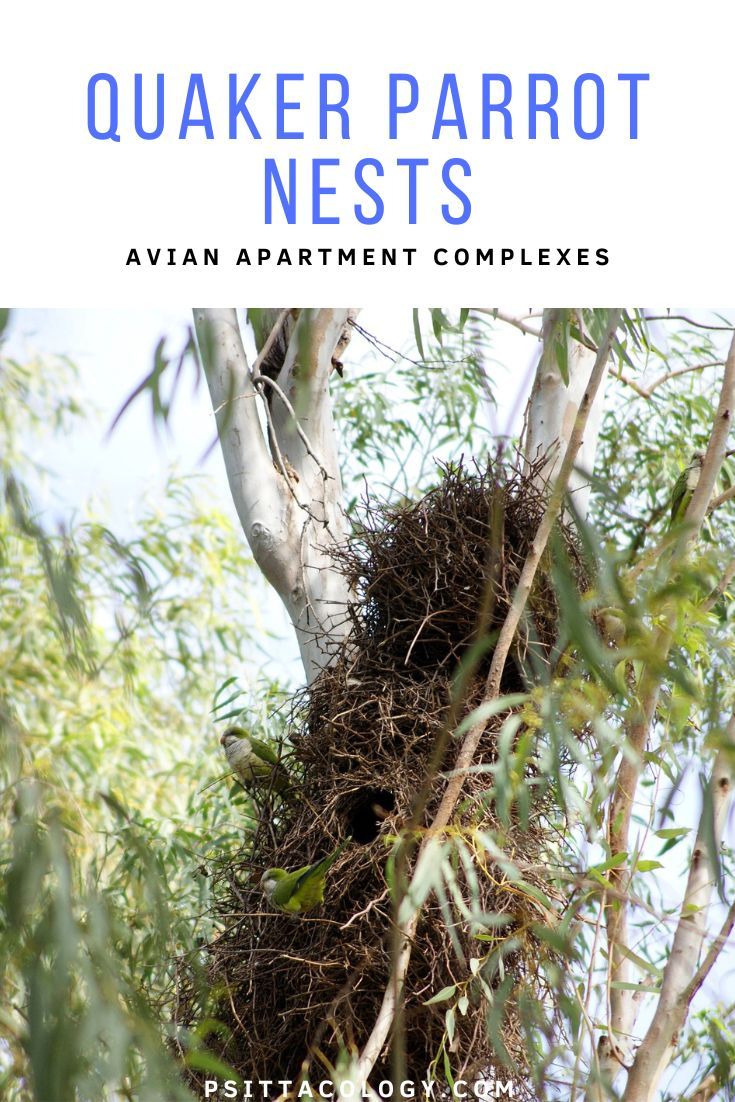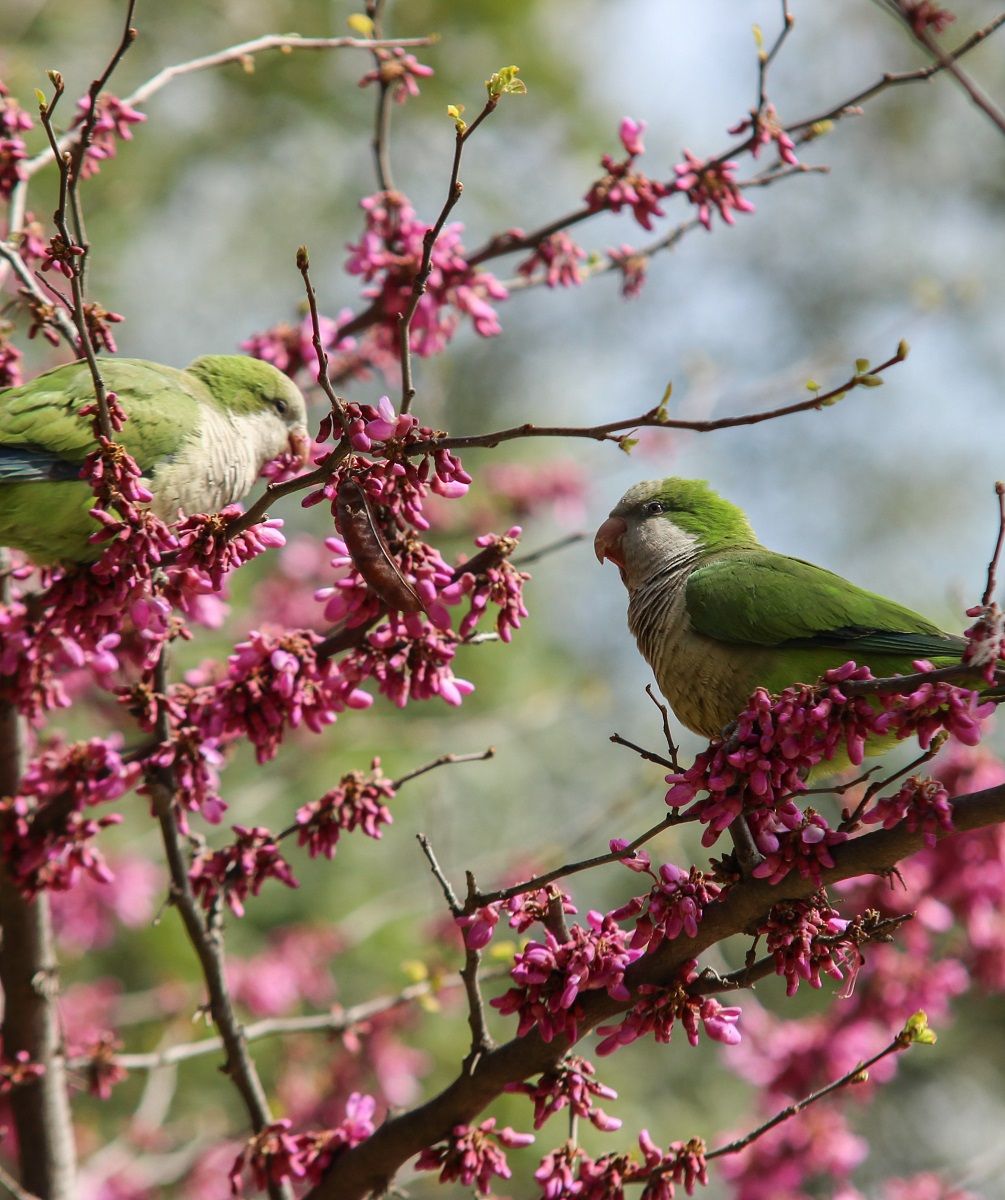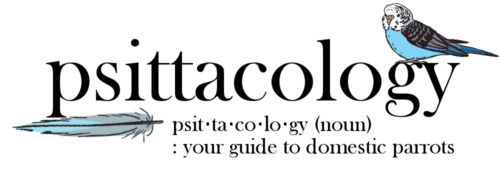If you’re into parrots, you’ve probably heard of Myiopsitta monachus: the quaker parrot or monk parakeet. This green and grey South American parakeet is popular as a pet, but did you know there’s more to it than that? Let me introduce you to the quaker parrot nest, one of the most elaborate homes in the bird world.
What does a quaker parrot nest look like? Why do they do it? Should you let them build one in the home? Let’s go into everything you need to know about these avian apartment complexes!
Quaker parrot nest in the wild
Quaker parrots are naturally found in South America, specifically Argentina, Paraguay, Bolivia and southwestern Brazil. In their natural habitat, these small parrots inhabit forests and other areas with at least some tree growth. They form flocks of up to 50 birds that forage and roost together.
The species’ shared nests are built in trees and other vertical structures, including things like telephone poles, A/C units, power lines and much more. Ornithologists have found there’s even a subspecies that nests on cliffs.
According to Parrots of the World, the nests are often made of hackberry (Celtis sp.) twigs, although it seems anything goes in a pinch. Everyone helps to find material, and the nest is expertly constructed (mostly by the males) to withstand wind and provide a safe place to live and rear young. Constant maintenance ensures the “apartments” remain in tip-top condition.
A quaker parrot nest can be individual, built and inhabited by just a single pair. In many cases, however, multiple pairs build nests in the same trees. The nests eventually merge together to form those huge, car-sized apartment complexes with multiple entrances that these birds are known for. One nest can weigh a whopping 1,000 kg (2,200 pounds) and is usually inhabited year-round.
Interestingly, it’s not just the quakers that inhabit these massive structures. Other species, including small birds of prey (spot-winged falconet, American kestrel) and different ducks (yellow-billed teal, whistling duck) will also take advantage of them.
Quakers have even been seen co-existing with tropical screech owls! Mammals like mice aren’t uncommon either.
Did you know? Quaker parrot nests are often attached to the nest of another, larger bird species: the jabiru stork (Jabiru mycteria). In one study in Brazil, 51% of quaker nests were found to be attached to jabiru nests.
Burger & Gochfeld, 2005

Invasive quakers
Although there are a few parrot species that have become invasive in different areas around the world (like the Indian ringneck), quakers really take the cake in this department. They can be found in dozens of different countries outside of their native range nowadays as a result of pets escaping or being set free intentionally.
It’s thought that their ability to build those big, communal nests plays an important role in quaker parrots being able to establish themselves so well. Whereas other parrots need hollow trees to nest in, quakers don’t really care where they end up! Almost any vertical structure works for them.
In the US, particularly in Florida, quakers are considered a serious problem by utility companies: utility poles make perfect nesting spots. In many other zones, these parrots have completely taken over parks, often displacing native species in the process.
Not surprising, because they can be pretty aggressive when they want to chase off uninvited visitors! They even block off their nests with (thorny) branches in some cases.
Aside from the nesting situation, quaker parrots also cause trouble for native species by outcompeting them for food. As a result some places, notably Madrid in Spain, have unfortunately begun culling them.

Quaker parrot nest in the home
Will a pet quaker parrot also start building one of those intricate nests if you give it the right materials at home? Yep, absolutely. In fact, if you’d like to breed this species, it’s usually recommended to let them construct a nest themselves rather than giving them a normal parrot nest box. They seem to much prefer it.
Your domestic quaker will generally get the urge to start building in spring. It’s usually recommended not to give parrots a place to nest in since it can trigger hormonal behavior like aggression, but to be honest, there isn’t much you can do to prevent it with these guys.
They will use anything and everything to build, instinctively weaving it together in expert fashion. As such, most folks just let them do their thing: at least it keeps them busy and provides great enrichment.
Materials
You can provide your monk parakeet with parrot-safe materials to build its nest with. If you live in an area where you can get palm leaves, those are absolutely perfect.
Other than that, try popsicle sticks, twigs, straws, paper rope or whatever you’ve got on hand! If you don’t, your bird is likely to start stealing items like pens, cutlery and even eyeglasses, anyway.
If you already have a quaker parrot, you’ll know that these birds can be territorial about their cage. Keep in mind that if you let yours buy a nest, this may or may not worsen.
You’ll have to be aware of how to deal with this behavior. Many parrot owners think it’s worth it: it’s honestly just immensely cool to watch a quaker at work.
Frequently asked questions
Due to their invasive potential, they are in various countries and states. Always check local regulations!
If you have any more questions about quaker parrot nests or if you’d like to share your own experiences with these colorful South American parrots, don’t hesitate to leave a comment below!
Sources & further reading
Briceño et al. (2019). Interactions between invasive Monk Parakeets (Myiopsitta monachus) and other bird species during nesting seasons in Santiago, Chile. Animals, 9(11), 923.
Burger, J., & Gochfeld, M. (2005). Nesting behavior and nest site selection in monk parakeets (Myiopsitta monachus) in the Pantanal of Brazil. Acta ethologica, 8(1), 23-34.
Eberhard, J. R. (1998). Breeding biology of the Monk Parakeet. The Wilson Bulletin, 463-473.
Forshaw, J. M., & Cooper, W. T. (1989). Parrots of the world (3rd ed., p. 672). Melbourne: Lansdowne editions.


I have a rescue Monk parrot. It is very happy with me but, am I depriving it of building a nest??
They can live a full life without having the opportunity to build a nest I’m sure. But you could always give it some material and see if it’s interested. It may not even take to it! But I do think it’s a great and easy form of providing enrichment to your bird if it does 🙂 good on you for rescuing.
My quackery loves to play keep away from me with his toys.
Ha, they are absolute characters! Small but full of spunk. 🙂
Gday. My wife and I live in Australia with a blue Quaker pair called Leo and Nutty. They have a large cage joined to a three room parrot sized house. Every night we have to clear their woven sticks inside their house so they can reach the food and water. Leo (male) does most of the weaving. Hope he soon learns to make tunnels… Not pets… Good mates.
They can keep themselves busy for hours with this stuff can’t they! Thanks for sharing 🙂 they sound like loads of fun.
They are a blast, they can succumb to fatty liver disease if their diet is off kilter (please research it). I lost my baby, yes a rescue at 7 years old he is survived by his life mate Gretta (also a rescue), and we have since adopted (purchased) a baby we call Lil Tweet. We adore our lil family and have added another rescue named Pearl which is a pearl cockatiel. All I know is that including our rescue pitbull TJ, we are a pretty happy family and these lil birds have their own distinct personalities and are a real joy and beautiful addition to our family.
Thanks for sharing! They sound beautiful 🙂
Two male Quakers will build a nest
Absolutely. Even solo quakers will 🙂
Absolutely LOVE my babygirl Olyvia! She about a year old & can hold entire convos with me (when she wants to). She is such an incredibly sweet girl & I try to read up on anything I can to help her in anyway possible. I will def be trying this as soon as I make it home. Only been gone a day but missing her dearly!! When she sees that I am asleep she will holler “MAMA”!! or “Wha Doin doin doin”??! 🤣 until I finally get up & open up her cage!
Thanks for sharing! They’re hilarious. Yes, give her some wooden coffee stirring sticks and see what she does! If no nest, she’ll at least enjoy chewing them up haha 🙂
I have a quaker. Not sure if female or male, but she talks a lot. Big vocabulary. She does make a nest once I hang a kerchief. She steals my white socks when I do laundry (actually I love to watch her place them in her nest). WE are close buddies. She also qeaves shoe strings (ENDS CUT OFF) THROUGH THE Bars of her cage. She works inside weaving then goes outside the cage to make the weave. She owns me not me owning her. She says. I love my mommy. Melts my heart.
Thank you for sharing! She sounds like an absolute joy. Have you tried giving her some wooden coffee stirrers or similar?! Sounds like she’d love some more building materials to try! 🙂
I have a Blue Quaker. She is 18 years old! She is protective of her cage so for the post part we put our hand at the door and say step up. Depending on her mood so put your hand in the cage at your own risk. We play go the bank she picks up coins and drops it in my hand . Her name is Sam, thought she was a boy til she laid an egg 😂. She gives kisses and says a lot of different things. I say Night Sam and she says night night. And aww sweet baby, gives kisses on lips and make kissing noise, says mommas sweet baby bird, and Come here Come here for a few. I love her so much. Some days she gets loud but I live in a house so who cares. She’s my baby girl.
Thank you for sharing! Sounds like a spunky delight of a bird 🙂 I wish you guys many more happy years together.
My question is that my Monk keep moving his tong in and out, not all the way out , he’s doing that most of the time recently.
It’s not look like the grinding his beak when relax , it’s different from that.
But he start doing that since 2 weeks.
By the way he’s healthy , eats , drink good , feathers is okay.
Anybody can explain please
Thanks in advanced.
Hi! Some parrots will play with their tongue to entertain themselves, but I do think you should visit an avian vet as soon as possible to make sure there isn’t anything more serious going on. He could have something stuck in his beak, have a sore on the inside, have a respiratory infection or something else. Good luck!
Is he hot and panting? Birds pant just as dogs pant.
My beloved Piper flew over the Rainbow Bridge almost 2yrs ago. I learned that he was a weaver and started putting 8″ plastic zip tyes in his cage bottom. By the afternoon they would all be in place. And if he ran out of fresh tyes, rebuilding a portion was not out of the question. Each time I took the cage out to be pressure washed, very few would come out. At last count, there were 3 5 gal buckets in place (approx 2500 tyes). You visit his handy work at https://www.rainbowsbridge.com/residents/PIPER004/Resident.htm
Thanks so much for sharing, that’s amazing. Can’t believe that pic of his cage! Rest easy Piper ♥